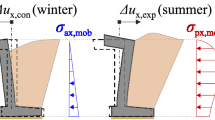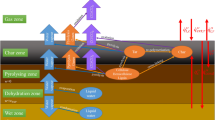We analyze the existing ordinary and express methods aimed at the determination of the frost resistance of building materials and demonstrate their advantages and disadvantages. We propose a new express method, which enables us to determine the durability of stone with the smallest labor consumption and high efficiency. This method is based on the introduced criterion of frost resistance computed according to the water absorption (wt.%) and compression strength in the water-saturated state. The obtained results are in good agreement with the results given by the available ordinary and express methods.

Similar content being viewed by others
References
DSTU B V.2.7-42-97. Building Materials. Methods for the Determination of Water Absorption, Density, and Frost Resistance of Building Materials and Products [in Ukrainian], Introduced on 18. 03. 1997.
DSTU B V.2.7-47-96. Concretes. Methods for the Determination of the Frost Resistance. General Requirements [in Russian], Introduced on 01.01.1997.
DSTU B V.2.7-50-96. Concretes. Dilatometric Method of Accelerated Determination of the Frost Resistance [in Russian], Introduced on 01.04.1997.
DSTU B V.2.7-51-96. Concretes. Structural-Mechanical Method of Accelerated Determination of the Frost Resistance [in Russian], Introduced on 01.04.1997.
GOST 26134-2016. Concretes. Ultrasonic Method of Determination of the Frost Resistance [in Russian], Introduced on 01.07.2017.
E. Liisma and L. M. Raado, “Internal and external damages of concrete with poor quality of coarse limestone aggregate,” in: Proc. of the Conf. “Central Europe toward Sustainable Building 2013: Sustainable Building and Refurbishment for Next Generations, Czech Technical University, Prague (2013), pp. 393–396.
M. Radlinski, J. Oleic, Q. Zhang, and K. Peterson, “Evaluation of the critical air-void system parameters for freeze-thaw resistant ternary concrete using the manual point-count and the flatbed scanner methods,” ASTM Int., 7, No. 4, 64–85 (2010).
M. V. Antonova, D. V. Glushko, and S. V. Belyaeva, “Comparative analysis of the European and Russian technical documentation of building materials,” Stroit. Unik. Zdanii Sooruzh., No. 4 (19), 34–50 (2014).
M. J. Setzer, P. Heine, S. Kasparek, S. Palecki, R. Auberg, V. Feldrappe, and E. Siebel, “Test methods of frost resistance of concrete: CIF-Test: Capillary suction, internal damage and freeze-thaw test – Reference method and alternative methods A and B – Materials and Structures,” Matér. Constr., 37, 743–753 (2004).
G. Bumanis, L. Dembovska, A. Korjakins, and D. Bajare, “Applicability of freeze-thaw resistance testing methods for high strength concrete at extreme –52.5°C and standard –18°C testing conditions,” Case Stud. Constr. Mater., 8, 139–149 (2018).
D. Kocáb, B. Kucharczyková, P. Daněk, T. Vymazal, P Hanuš, and R Halamová, “Destructive and non-destructive assessment of the frost resistance of concrete with different aggregate,” IOP Conf. Series: Mater. Sci. Eng., 379, No. 1, 012–022 (2018).
MI 2490-98 GSI. Silicate Materials. Methods for Determination of the Frost Resistance According to the Structural-Mechanical Characteristics [in Russian], Introduced on 01.08.1998.
GOST 379-2015. Silicate Bricks, Rocks, Blocks and Partition Plates. General Specifications [in Russian], Introduced on 01.10.2015.
O. D. Parashchenko, A. S. Shulga, and K. A. Valeshko, Quality Control of Building Materials [in Russian], Budivel’nyk, Kyiv (1985).
BS EN 206:2013. Concrete—Specification, Performance, Production, and Conformity (+A1:2016) (Incorporating Corrigendum May 2014).
RILEM Technical Committee. TDC, CDF Test, Test Method for the Freeze-Thaw-Resistance of Concrete with Sodium Chloride Solution, Germany (2001).
G. М. Grushevskii, О. О. Ivaev, S. K. Romanov, and V. V. Khodykin, Reinforced Concrete Structures: A Textbook [in Russian], Nizhnii Novgorod State University of Architecture and Civil Engineering, Nizhnii Novgorod (2006).
A. S. Vasil’ev, Mathematical Modeling and Investigation of Composite Materials in the Region of Ultimate Strength [in Russian], Candidate-Degree Thesis (Technical Sciences), Komsomolsk-on-Amur (2016).
Yu. V. Vadetskii (editor), Oil and Gas Encyclopedia (K–P) [in Russian], Vol. 2, Moscow Branch “Neft’ i Gaz” of the International Academy of Informatization, “VNIIOÉNG” JSC, Moscow (2003).
DSTU B В.2.7-248:2011. Wall Materials. Methods for the Determination of Ultimate Strengths in Compression and Bending [in Russian], Introduced on 30.12.2011.
L. I. Dvorkin and O. L. Dvorkin, Computational Prediction and the Design of Concrete Compositions. A Textbook [in Russian], Infra–Inzheneriya, Moscow (2016).
Author information
Authors and Affiliations
Corresponding author
Additional information
Translated from Fizyko-Khimichna Mekhanika Materialiv, Vol. 56, No. 2, pp. 95–100, March–April, 2020.
Rights and permissions
About this article
Cite this article
Piddubnyi, S.V., Tatarchenko, H.О. & Sokolenko, V.М. Express Method for the Evaluation of the Frost Resistance of Silicate Building Materials. Mater Sci 56, 240–246 (2020). https://doi.org/10.1007/s11003-020-00422-0
Received:
Published:
Issue Date:
DOI: https://doi.org/10.1007/s11003-020-00422-0




